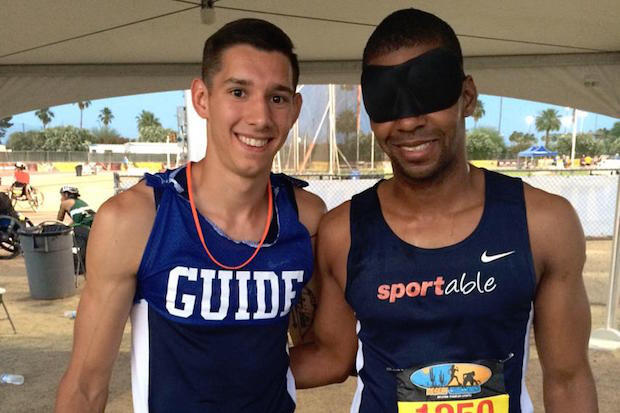
Jan. 3, 2018
VCU engineering student finds athletic outlet and creative inspiration as a guide runner
Freddy Derenthal is helping runners who are visually impaired, and exploring ways engineers can help athletes with disabilities overcome training and cost barriers.
Share this story
When doctoral student Freddy Derenthal is not in the lab, you may find him training alongside an athlete with visual impairments. Derenthal is a guide runner, which means he helps runners who are visually impaired by running alongside them and helping them compete at their highest level. Guide running, which Derenthal started a year ago, has helped him grow as an athlete — and it has inspired him as an engineer.
Derenthal was a track athlete and played rugby as an undergraduate student at Virginia Military Institute and continued running when he came to Virginia Commonwealth University to start his Ph.D. in electrical engineering. He heard about Sportable Adaptive Sports and Recreation Inc., a Richmond-based nonprofit specializing in programs for athletes with impairments, and was immediately interested in volunteering with the organization.
“I showed up at Sportable and I was asked what my best times were,” he recalled. “Fool that I am, I gave 5:40, my best high school time for the mile.”
Derenthal was paired with Antoine Craig, a highly dedicated runner whose vision is rated T11, the highest level of impairment. Craig had been running in distance events and was interested in competing as a sprinter.
“It took a while for Sportable to find someone who could keep up with me, so it was lucky that Freddy and I connected,” Craig said.
The two began running together four times a week, connected by a shoestring tied between their fingers so Craig knows where Derenthal is at all times.
Freddy was all in, every day, through every grueling, hot practice.
“Freddy was all in, every day, through every grueling, hot practice. We grew together — literally tied to each other,” Craig said.
Keeping up with Craig, who aspires to compete in the 2020 Paralympic Games in Tokyo, challenged Derenthal.
“To be a guide runner, you have to be as fast as the athlete you’re working with because you are their eyes,” he said. “As we ran, I would say, ‘Okay, turn right in three, two, one.’ It takes a lot of synchronization and coordination. We started out much slower than normal, then built up speed.”
As they improved, Craig and Derenthal set their sights on a high-profile race, ultimately qualifying for the 2017 Desert Challenge Games in Phoenix. The event is one of nine World Para Athletics Grand Prix races and the only one in North America. With support from friends and family, Craig and Derenthal competed in the 100-, 200- and 400-meter sprints. Craig finished with national championship-qualifying times in all events and a world championship-qualifying time in the 400-meter, winning the Desert Challenge gold medal in 1:01.70.
“They announced that our heat included a T11 runner who had a 400-meter world record and got the gold medal, and I knew it was Antoine,” Derenthal said. “The feeling was indescribable. I know I’ll tell my grandkids about it.”
Derenthal said training with an athlete of Craig’s caliber boosted his own focus and self-discipline. It also made him aware of challenges people with disabilities face — and engineers could help navigate.
“Guide running opened my eyes to accessibility — really ‘inaccessibility’ — issues people with disabilities are tasked with,” he said.
He sees a need for a system that alerts runners to obstacles so runners with visual impairments can train independently. He would also like to see an improvement to the clunky pole-based wheelchair steering mechanisms that force athletes to push the wheel on either side of the chair and hit a steering stick in front to control direction.
“There could be a much more efficient means of movement, perhaps weight-based, so the athlete could turn hands-free, which would save energy and let the athlete maintain momentum,” he said.
Derenthal also thinks engineers can help athletes with disabilities overcome another barrier: cost.
“There’s a lot out there already — for millionaires. I’d love to see engineers take an expensive gadget for athletes with disabilities and make it cost-effective,” he said. “That would make a great capstone [project].”
Subscribe for free to the VCU News email newsletter at http://newsletter.news.vcu.edu/ and receive a selection of stories, videos, photos, news clips and event listings in your inbox every Monday and Thursday during the academic year and every Thursday during the summer.
Subscribe to VCU News
Subscribe to VCU News at newsletter.vcu.edu and receive a selection of stories, videos, photos, news clips and event listings in your inbox.












